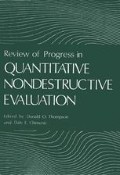Abstract
An initial study of a technique proposed for the nondestructive testing of metal matrix composites is the subject of this paper. These composites are manufactured in the form of approximately 1/2-mm-diameter “precursor” wires. Larger structures are fabricated by diffusion bonding of lay-ups. Reliable nondestructive quality control indicators of wire integrity have not yet been developed although a number of possibilities are being examined.1 Testing of the precursor wires is difficult because current manufacturing processes produce wires that may be entirely satisfactory but that vary in cross-sectional geometry, in surface properties, and sometimes in the amount of matrix material that is present. Techniques based on observations of wire resistance, surface emissivity, and sound emission signatures are difficult to interpret because of these characteristics. Wire imaging using x-ray or neutron techniques is also difficult because large lengths of wire must be examined with a resolution in the plane of the wire exceeding 50 line pairs per millimeter.
Access this chapter
Tax calculation will be finalised at checkout
Purchases are for personal use only
Preview
Unable to display preview. Download preview PDF.
References
C. W. Anderson and G. V. Blessing, “Detection of Material Defects in Graphite-Reinforced Aluminum,” NSWC TR 79-222, Naval Surface Weapons Center, 1979.
E. P. Muntz, Analysis of the Significance of Scattered Radiation in Reduced Dose Mammography, Med. Phys. 6:(2)110 (1979).
E. P. Muntz, A. Proudian, and P. B. Scott, “Radiographic System with Xerographic Printing,” U. S. Patent 3, 774, 029 (1973).
E. P. Muntz, J. Lewis, and T. Azzarelli, On the Characteristics of Electron Radiographic Images in Diagnostic Radiology, in: “Medical X-ray Photo-Optical System Evaluation,” 56, 208, SPIE Seminar Proceedings (1974).
A. Fenster, D. Plewes, and H. E. Johns, Efficiency and Resolution of Ionography in Diagnostic Radiology, Med. Phys. 1 (1) 1 (1974).
G. T. Barnes, Characteristics of Scatter, in: “Reduced Dose Mammography,” W. W. Logan and E. P. Muntz, eds., Masson, N.Y. (1979).
M. M. Ter-Pogossian, “The Physical Aspects of Diagnostic Radiology,” Harper and Row, New York (1969).
H. E. Johns and J. R. Cunningham, “The Physics of Radiology,” C. C. Thomas, Springfield, Ill. (1974).
T. R. Fewell and R. E Shuping, “Handbook of Mammographie X-ray Spectra,” HEW 79-8071, U. S. D. H. E. W. Publication (1979).
K. R. Peschmann and G. Grosche, Amplification and Entailed Resolution Degradation in High Pressure Gas Ionography, Med. Phys. 4:(3)202 (1977).
L. A. Lehmann, R. E. Alvarez, A. Macovski, W. R. Brody, N. J. Pelc, S. J. Riederer, and A. J. Hall, Generalized Image Combination in Dual kVp Digital Radiography, Med. Phys. 8:(5)659 (1981).
J. H. Hubbell, “Photon Cross Sections, Attenuation Coefficients and Energy Absorption Coefficients from 10 keV to 100 GeV,” NSRDS-NBS 29, U. S. Government Printing Office, Washington, D.C. (1969).
Author information
Authors and Affiliations
Editor information
Editors and Affiliations
Rights and permissions
Copyright information
© 1983 Plenum Press, New York
About this chapter
Cite this chapter
Muntz, E.P., Sve, C., Hawkins, G.F. (1983). A Technique for the Nondestructive Detection of Voids and Composition Anomalies in Metal Matrix Composite Wires Using X or γ Rays. In: Thompson, D.O., Chimenti, D.E. (eds) Review of Progress in Quantitative Nondestructive Evaluation. Library of Congress Cataloging in Publication Data, vol 2A. Springer, Boston, MA. https://doi.org/10.1007/978-1-4613-3706-5_44
Download citation
DOI: https://doi.org/10.1007/978-1-4613-3706-5_44
Publisher Name: Springer, Boston, MA
Print ISBN: 978-1-4613-3708-9
Online ISBN: 978-1-4613-3706-5
eBook Packages: Springer Book Archive

